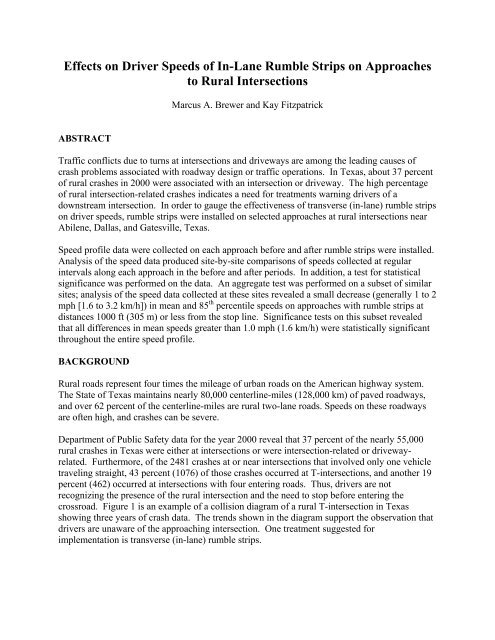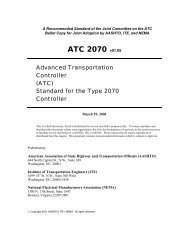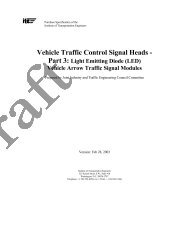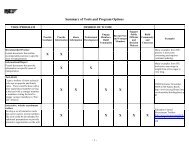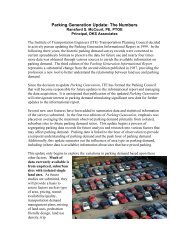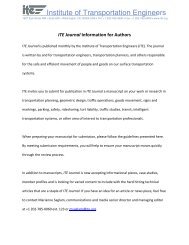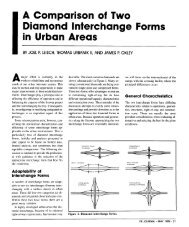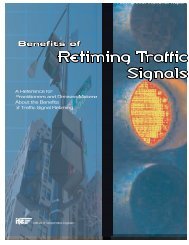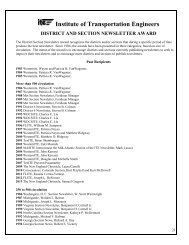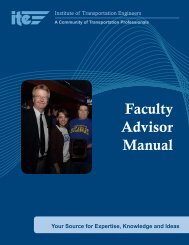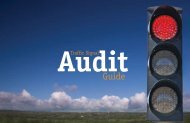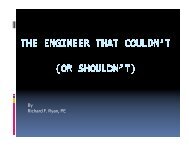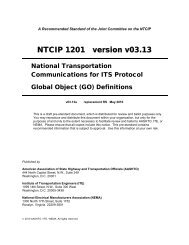Effects on Driver Speeds of In-Lane Rumble Strips on Approaches to ...
Effects on Driver Speeds of In-Lane Rumble Strips on Approaches to ...
Effects on Driver Speeds of In-Lane Rumble Strips on Approaches to ...
You also want an ePaper? Increase the reach of your titles
YUMPU automatically turns print PDFs into web optimized ePapers that Google loves.
<str<strong>on</strong>g>Effects</str<strong>on</strong>g> <strong>on</strong> <strong>Driver</strong> <strong>Speeds</strong> <strong>of</strong> <strong>In</strong>-<strong>Lane</strong> <strong>Rumble</strong> <strong>Strips</strong> <strong>on</strong> <strong>Approaches</strong><br />
<strong>to</strong> Rural <strong>In</strong>tersecti<strong>on</strong>s<br />
Marcus A. Brewer and Kay Fitzpatrick<br />
ABSTRACT<br />
Traffic c<strong>on</strong>flicts due <strong>to</strong> turns at intersecti<strong>on</strong>s and driveways are am<strong>on</strong>g the leading causes <strong>of</strong><br />
crash problems associated with roadway design or traffic operati<strong>on</strong>s. <strong>In</strong> Texas, about 37 percent<br />
<strong>of</strong> rural crashes in 2000 were associated with an intersecti<strong>on</strong> or driveway. The high percentage<br />
<strong>of</strong> rural intersecti<strong>on</strong>-related crashes indicates a need for treatments warning drivers <strong>of</strong> a<br />
downstream intersecti<strong>on</strong>. <strong>In</strong> order <strong>to</strong> gauge the effectiveness <strong>of</strong> transverse (in-lane) rumble strips<br />
<strong>on</strong> driver speeds, rumble strips were installed <strong>on</strong> selected approaches at rural intersecti<strong>on</strong>s near<br />
Abilene, Dallas, and Gatesville, Texas.<br />
Speed pr<strong>of</strong>ile data were collected <strong>on</strong> each approach before and after rumble strips were installed.<br />
Analysis <strong>of</strong> the speed data produced site-by-site comparis<strong>on</strong>s <strong>of</strong> speeds collected at regular<br />
intervals al<strong>on</strong>g each approach in the before and after periods. <strong>In</strong> additi<strong>on</strong>, a test for statistical<br />
significance was performed <strong>on</strong> the data. An aggregate test was performed <strong>on</strong> a subset <strong>of</strong> similar<br />
sites; analysis <strong>of</strong> the speed data collected at these sites revealed a small decrease (generally 1 <strong>to</strong> 2<br />
mph [1.6 <strong>to</strong> 3.2 km/h]) in mean and 85 th percentile speeds <strong>on</strong> approaches with rumble strips at<br />
distances 1000 ft (305 m) or less from the s<strong>to</strong>p line. Significance tests <strong>on</strong> this subset revealed<br />
that all differences in mean speeds greater than 1.0 mph (1.6 km/h) were statistically significant<br />
throughout the entire speed pr<strong>of</strong>ile.<br />
BACKGROUND<br />
Rural roads represent four times the mileage <strong>of</strong> urban roads <strong>on</strong> the American highway system.<br />
The State <strong>of</strong> Texas maintains nearly 80,000 centerline-miles (128,000 km) <strong>of</strong> paved roadways,<br />
and over 62 percent <strong>of</strong> the centerline-miles are rural two-lane roads. <strong>Speeds</strong> <strong>on</strong> these roadways<br />
are <strong>of</strong>ten high, and crashes can be severe.<br />
Department <strong>of</strong> Public Safety data for the year 2000 reveal that 37 percent <strong>of</strong> the nearly 55,000<br />
rural crashes in Texas were either at intersecti<strong>on</strong>s or were intersecti<strong>on</strong>-related or drivewayrelated.<br />
Furthermore, <strong>of</strong> the 2481 crashes at or near intersecti<strong>on</strong>s that involved <strong>on</strong>ly <strong>on</strong>e vehicle<br />
traveling straight, 43 percent (1076) <strong>of</strong> those crashes occurred at T-intersecti<strong>on</strong>s, and another 19<br />
percent (462) occurred at intersecti<strong>on</strong>s with four entering roads. Thus, drivers are not<br />
recognizing the presence <strong>of</strong> the rural intersecti<strong>on</strong> and the need <strong>to</strong> s<strong>to</strong>p before entering the<br />
crossroad. Figure 1 is an example <strong>of</strong> a collisi<strong>on</strong> diagram <strong>of</strong> a rural T-intersecti<strong>on</strong> in Texas<br />
showing three years <strong>of</strong> crash data. The trends shown in the diagram support the observati<strong>on</strong> that<br />
drivers are unaware <strong>of</strong> the approaching intersecti<strong>on</strong>. One treatment suggested for<br />
implementati<strong>on</strong> is transverse (in-lane) rumble strips.
Major Road<br />
Minor Road<br />
Figure 1. Collisi<strong>on</strong> Diagram <strong>of</strong> a T-<strong>In</strong>tersecti<strong>on</strong>.<br />
CHARACTERISTICS OF RUMBLE STRIPS<br />
<strong>In</strong>-lane rumble strips are grooved or raised patterns <strong>on</strong> a roadway surface that provide an audible<br />
and tactile warning system <strong>to</strong> mo<strong>to</strong>rists approaching a decisi<strong>on</strong> point. They are well-suited for<br />
rural roadways that typically have low volumes, infrequent traffic c<strong>on</strong>trol devices, and mo<strong>to</strong>rists<br />
who may not be as attentive <strong>to</strong> roadway c<strong>on</strong>diti<strong>on</strong>s as urban drivers. <strong>In</strong>-lane or transverse<br />
rumble strips have been used for many years in work z<strong>on</strong>es, intersecti<strong>on</strong>s, and other areas that<br />
merit special measures for alerting drivers. Although rumble strips are not a speed-c<strong>on</strong>trol<br />
device, they are generally thought <strong>to</strong> be effective in reducing speed and increasing s<strong>to</strong>p<br />
compliance (1).<br />
A report by Zaidel et al. (2) describes four basic characteristics <strong>of</strong> rumble strips:<br />
• They involve certain degrading <strong>of</strong> the roadway pavement surface smoothness.<br />
• The basic treatment element is either a groove in the pavement about 0.5 inch (12 mm)<br />
deep by 4 inches (10 cm) wide or a tacked-<strong>on</strong> strip <strong>of</strong> rough pavement material 0.38 <strong>to</strong><br />
0.75 inch (10 <strong>to</strong> 20 mm) high and 4 inches (10 cm) <strong>to</strong> many meters wide.<br />
• The basic elements are repeatedly placed as transverse strips across the roadway in a<br />
certain geometric pattern, starting some distance upstream and s<strong>to</strong>pping some distance<br />
before the critical locati<strong>on</strong>. The treatment distance should corresp<strong>on</strong>d <strong>to</strong> the declarati<strong>on</strong>
distance <strong>of</strong> the 85 th speed percentile, empirically observed before the treatment; about 32<br />
<strong>to</strong> 49 ft (10 <strong>to</strong> 15 m) <strong>of</strong> pavement should be left clear before the s<strong>to</strong>p line.<br />
• The rumble treatment is assumed <strong>to</strong> provide drivers with visual, audi<strong>to</strong>ry, and tactilevibra<strong>to</strong>ry<br />
stimulati<strong>on</strong>, thus compelling them <strong>to</strong> be attentive <strong>to</strong> the demands <strong>of</strong> the<br />
situati<strong>on</strong>.<br />
Figure 2 illustrates an example <strong>of</strong> a set <strong>of</strong> in-lane rumble strips and a close-up view <strong>of</strong> an in-lane<br />
rumble strip.<br />
(a) Set <strong>of</strong> <strong>In</strong>-<strong>Lane</strong> <strong>Rumble</strong> <strong>Strips</strong><br />
(b) Close-Up View.<br />
Figure 2. Example <strong>of</strong> an <strong>In</strong>-<strong>Lane</strong> <strong>Rumble</strong> Strip <strong>In</strong>stallati<strong>on</strong>.<br />
A wide variety <strong>of</strong> rumble strip c<strong>on</strong>figurati<strong>on</strong>s have been used. These include a c<strong>on</strong>tinuous<br />
stretch <strong>of</strong> textured pavement, single strips, and – what is currently the most widely-used<br />
c<strong>on</strong>figurati<strong>on</strong> – intermittently spaced sets <strong>of</strong> strips. There are differing perspectives c<strong>on</strong>cerning<br />
the purpose <strong>of</strong> rumble strips. One is that rumble strips are intended <strong>to</strong> produce noise and<br />
vibrati<strong>on</strong> that will reduce the speed at which drivers feel comfortable traveling. The other<br />
viewpoint is that the noise and vibrati<strong>on</strong> caused by the treatment will simply alert the driver <strong>to</strong><br />
upcoming roadway c<strong>on</strong>diti<strong>on</strong>s that warrant special attenti<strong>on</strong>. <strong>In</strong> either case, the sound and<br />
vibrati<strong>on</strong> produced by the rumble strips must be severe enough <strong>to</strong> gain the driver’s attenti<strong>on</strong> in<br />
order <strong>to</strong> have any positive effect <strong>on</strong> safety (1).<br />
EFFECTIVENESS OF IN-LANE RUMBLE STRIPS<br />
Crash Reducti<strong>on</strong><br />
According <strong>to</strong> a 1993 synthesis <strong>of</strong> practice <strong>on</strong> rumble strips (3), 89 percent <strong>of</strong> state highway<br />
agencies have installed rumble strips at important locati<strong>on</strong>s such as intersecti<strong>on</strong> approaches,<br />
horiz<strong>on</strong>tal curves, and work z<strong>on</strong>es. Harwood reports that safety evaluati<strong>on</strong>s in the literature<br />
generally show that the installati<strong>on</strong> <strong>of</strong> rumble strips is effective in reducing crashes <strong>on</strong><br />
intersecti<strong>on</strong> approaches (3). Table 1 summarizes the results <strong>of</strong> the studies referenced, all <strong>of</strong><br />
which used a before-and-after study design. These studies show that the crash reducti<strong>on</strong><br />
effectiveness <strong>of</strong> in-lane rumble strips can range from 14 <strong>to</strong> 100 percent; however, the studies
were generally small and varied greatly in quality and completeness. Only two <strong>of</strong> the studies<br />
found a statistically significant crash reducti<strong>on</strong> from rumble strip installati<strong>on</strong>. Harwood notes<br />
that despite the lack <strong>of</strong> rigor in the evaluati<strong>on</strong> design, rumble strips can be effective and should<br />
be c<strong>on</strong>sidered at locati<strong>on</strong>s where rear-end crashes and ran-S<strong>to</strong>p-sign crashes occur, because these<br />
types <strong>of</strong> crashes involve an apparent lack <strong>of</strong> driver attenti<strong>on</strong>.<br />
Study and<br />
Date<br />
Table 1. Crash Reducti<strong>on</strong> <str<strong>on</strong>g>Effects</str<strong>on</strong>g> for <strong>In</strong>-<strong>Lane</strong> <strong>Rumble</strong> <strong>Strips</strong><br />
(Summarized from 1993 Synthesis) (3).<br />
Locati<strong>on</strong> Num Safety Measure Percent<br />
<strong>of</strong><br />
Change in<br />
Sites<br />
Safety<br />
Measure<br />
California 4 Total crashes -59 <strong>to</strong><br />
-100<br />
Statistically<br />
Significant?<br />
Kermit &<br />
Not Stated<br />
Hein, 1962<br />
Kermit, 1968 California 1 Ran-S<strong>to</strong>p-Sign Crashes -50 Not Stated<br />
Owens, 1967 Minnesota 2 Total Crashes -50 No<br />
Illinois, 1970 Illinois 5 Total Crashes<br />
+5 Not Stated<br />
Ran-S<strong>to</strong>p-Sign Crashes -50 Not Stated<br />
TRRL, 1977 U.K. 10 Total Crashes<br />
-39<br />
No<br />
Related Crashes<br />
-50 Yes<br />
Virginia, 1981 Virginia 9 Total Crashes<br />
-37 Not Stated<br />
Fatal Crashes<br />
-93 Not Stated<br />
<strong>In</strong>jury Crashes<br />
-37 Not Stated<br />
PDO Crashes<br />
-25 Not Stated<br />
Total Crash Rate<br />
-44 Not Stated<br />
Related Crash Rate -89 Not Stated<br />
Carstens, 1982 Iowa 21 Primary Highway Approach<br />
Total Crash Rate<br />
Ran-S<strong>to</strong>p-Sign Crashes<br />
Sec<strong>on</strong>dary Highway<br />
Approach<br />
Total Crash Rate<br />
Ran-S<strong>to</strong>p-Sign Crashes<br />
Zaidel,<br />
Hakkert, &<br />
Barkan, 1986<br />
-51<br />
-38<br />
Yes<br />
No<br />
-1<br />
No<br />
+3<br />
No<br />
Israel 1 Right-Angle Crashes -50 <strong>to</strong> -67 No<br />
Moore, 1987 Louisiana 24 Total Crashes<br />
Fatal and <strong>In</strong>jury Crashes<br />
Daytime Crashes<br />
Nighttime Crashes<br />
PennDot, 1991 Pennsylvania 8 Total Crashes<br />
Ran-S<strong>to</strong>p-Sign Crashes<br />
TRRL = Transport and Road Research Labora<strong>to</strong>ry<br />
PDO = Property Damage Only<br />
-29<br />
-14<br />
-14<br />
-50<br />
-40<br />
-59<br />
Not Stated<br />
Not Stated<br />
Not Stated<br />
Not Stated<br />
Not Stated<br />
Not Stated
Decelerati<strong>on</strong> Behavior<br />
The 1993 synthesis <strong>on</strong> rumble strips c<strong>on</strong>cluded that previous studies show that rumble strip<br />
installati<strong>on</strong>s <strong>on</strong> intersecti<strong>on</strong> approaches do result in a small reducti<strong>on</strong> in vehicle speeds (3). Some<br />
vehicles are slowed more than others, however, and it appears that speed variance <strong>on</strong> the<br />
intersecti<strong>on</strong> approach may be increased. Harwood (3) reported <strong>on</strong> the following studies that<br />
investigated the effects <strong>of</strong> rumble strips <strong>on</strong> approach speeds:<br />
• A 1962 study in California used rumble strips <strong>on</strong> <strong>on</strong>e approach <strong>to</strong> a T-intersecti<strong>on</strong> where<br />
drivers must slow <strong>to</strong> turn but are not required <strong>to</strong> s<strong>to</strong>p. Table 2 shows that rumble strips<br />
increased the decelerati<strong>on</strong> rate used by drivers between 450 and 1000 ft (137 and 305 m)<br />
from the intersecti<strong>on</strong> and decreased the decelerati<strong>on</strong> rate used by drivers within 450 ft<br />
(137 m) <strong>of</strong> the intersecti<strong>on</strong>.<br />
• A 1967 Minnesota study examined the effects <strong>of</strong> rumble strips <strong>on</strong> vehicle speed for six<br />
intersecti<strong>on</strong> approaches. <strong>Speeds</strong> <strong>of</strong> free-flowing vehicles were measured at distances <strong>of</strong><br />
1500, 1000, 500, and 300 ft (458, 305, 153, and 92 m) from the s<strong>to</strong>p. The study found<br />
that the presence <strong>of</strong> rumble strips reduced average speeds by 2 <strong>to</strong> 3 mph (3.2 <strong>to</strong> 4.8 km/h)<br />
at each <strong>of</strong> the observati<strong>on</strong> points (see Table 3). While rumble strips decreased vehicle<br />
speeds, they increased the speed variance <strong>on</strong> the intersecti<strong>on</strong> approaches at all distances<br />
from the intersecti<strong>on</strong> greater than 300 ft (92 m).<br />
• A 1977 study in the United Kingdom studied the effects <strong>of</strong> rumble areas <strong>on</strong> speeds at 10<br />
sites where they were installed upstream <strong>of</strong> roundabouts, four-way intersecti<strong>on</strong>s, T-<br />
intersecti<strong>on</strong>s, horiz<strong>on</strong>tal curves, and small <strong>to</strong>wns. The effects <strong>of</strong> the rumble areas <strong>on</strong><br />
speed were not c<strong>on</strong>sistent. <strong>In</strong> some cases the presence <strong>of</strong> the rumble area appeared <strong>to</strong><br />
cause drivers <strong>to</strong> choose a larger speed reducti<strong>on</strong> between the 1312 ft and 164 ft (400 m<br />
and 50 m) points <strong>on</strong> the approach; however, at other sites the opposite appeared <strong>to</strong> be<br />
true.<br />
• A 1992 study evaluated the effectiveness <strong>of</strong> rumble strips in reducing vehicle speeds <strong>on</strong><br />
seven approaches <strong>to</strong> T-intersecti<strong>on</strong>s in Ohio. The speeds were measured 300 ft (92 m)<br />
downstream <strong>of</strong> the first rumble strip pattern. On five <strong>of</strong> the seven approaches, there was<br />
a statistically significant reducti<strong>on</strong> in the mean vehicle speed (see Table 4).<br />
Table 2. <strong>Speeds</strong> <strong>on</strong> an <strong>In</strong>tersecti<strong>on</strong> Approach Where <strong>Driver</strong>s are<br />
Required <strong>to</strong> Slow But Not S<strong>to</strong>p (3).<br />
Locati<strong>on</strong> Measurement Before <strong>Rumble</strong><br />
Strip <strong>In</strong>stallati<strong>on</strong><br />
After <strong>Rumble</strong><br />
Strip <strong>In</strong>stallati<strong>on</strong><br />
A 85 th percentile speed at 1000 ft (305 m) from the<br />
intersecti<strong>on</strong> and before the first rumble strip<br />
44.0 mph<br />
(71 km/h)<br />
46.0 mph<br />
(74 km/h)<br />
Average decelerati<strong>on</strong> rate from Locati<strong>on</strong> A <strong>to</strong> B 0.57 ft/sec 2<br />
(0.17 m/sec 2 )<br />
1.43 ft/sec 2<br />
(0.44 m/sec 2 )<br />
B 85 th percentile speed at 450 ft (137 m) from the<br />
intersecti<strong>on</strong> after three rumble strips have been<br />
41 mph<br />
(66 km/h)<br />
37 mph<br />
(60 km/h)<br />
crossed<br />
Average decelerati<strong>on</strong> rate from Locati<strong>on</strong> B <strong>to</strong> C 3.46 ft/sec 2 2.70 ft/sec 2<br />
(1.1 m/sec 2 )<br />
C 85 th percentile speed at intersecti<strong>on</strong> 14.8 mph<br />
(23.8 km/h)<br />
(0.8 m/sec 2 )<br />
15.1 mph<br />
(24.3 km/h)
Distance From<br />
<strong>In</strong>tersecti<strong>on</strong> (ft)<br />
Table 3. Mean <strong>Speeds</strong> at Specified Distances for Six <strong>Approaches</strong> <strong>to</strong><br />
S<strong>to</strong>p-C<strong>on</strong>trolled <strong>In</strong>tersecti<strong>on</strong>s in Minnesota (3).<br />
Average Speed in mph (km/h)<br />
Before <strong>Rumble</strong> After <strong>Rumble</strong> Difference<br />
Strip <strong>In</strong>stallati<strong>on</strong> Strip <strong>In</strong>stallati<strong>on</strong><br />
31.01 (49.9) 27.99 (45.1) 3.02 (4.9)<br />
36.57 (58.9) 33.59 (54.1) 2.98 (4.8)<br />
43.70 (70.4) 41.39 (66.6) 2.31 (3.7)<br />
47.26 (76.1) 44.47 (71.6) 2.79 (4.5)<br />
Statistically significant<br />
before/after difference?<br />
300<br />
500<br />
1000<br />
1500<br />
Yes<br />
Yes<br />
Yes<br />
Yes<br />
Away from area 52.09 (83.9) 52.58 (84.7) -0.49 (-0.8) No<br />
Site<br />
1<br />
2<br />
3<br />
4<br />
5<br />
6<br />
7<br />
Table 4. Effect <strong>of</strong> <strong>Rumble</strong> <strong>Strips</strong> <strong>on</strong> Vehicle Speed <strong>on</strong> Seven <strong>Approaches</strong> <strong>to</strong> S<strong>to</strong>p-<br />
C<strong>on</strong>trolled <strong>In</strong>tersecti<strong>on</strong>s in Ohio (3).<br />
Mean Speed in mph (km/h) 300 ft (92 m)<br />
Statistically Significant at<br />
downstream <strong>of</strong> first rumble strip<br />
95% C<strong>on</strong>fidence Level?<br />
Before After Reducti<strong>on</strong><br />
41.9 (67.5) 35.9 (57.8) 6.0 (9.7)<br />
47.9 (77.1) 39.9 (64.2) 8.0 (12.9)<br />
43.9 (70.7) 45.9 (73.9) -2.0 (-3.2)<br />
45.9 (73.9) 41.9 (67.5) 4.0 (6.4)<br />
51.9 (83.6) 49.9 (80.3) 2.0 (3.2)<br />
53.9 (86.8) 51.9 (83.6) 2.0 (3.2)<br />
53.9 (86.8) 49.9 (80.3) 4.0 (6.4)<br />
Zaidel et al. (2) evaluated the use <strong>of</strong> rumble strips <strong>on</strong> <strong>on</strong>e s<strong>to</strong>p-c<strong>on</strong>trolled rural intersecti<strong>on</strong><br />
approach in Israel. <strong>Speeds</strong> were m<strong>on</strong>i<strong>to</strong>red for over 2500 lead vehicles at eight points al<strong>on</strong>g the<br />
1377 ft (420 m) leading <strong>to</strong> the intersecti<strong>on</strong>. A <strong>to</strong>tal <strong>of</strong> 38 rumble strips were placed over a<br />
distance <strong>of</strong> 883 ft (269 m) upstream <strong>of</strong> the s<strong>to</strong>p line. The researchers found that mean speeds<br />
were reduced by 5 <strong>to</strong> 43 percent while the speed variance increased (as much as 60 percent) with<br />
the installati<strong>on</strong> <strong>of</strong> the strips. The researchers c<strong>on</strong>cluded that:<br />
• <strong>Rumble</strong> strips lowered speeds by an average <strong>of</strong> 40 percent.<br />
• <strong>Rumble</strong> strips had a small positive effect <strong>on</strong> compliance rate.<br />
• With no pavement treatment, decelerati<strong>on</strong> began at 492 ft (150 m) and peaked within the<br />
last 197 ft (60 m); with the rumble strips, most <strong>of</strong> the decelerati<strong>on</strong> <strong>to</strong>ok place before the<br />
vehicle passed the first strip, followed by an additi<strong>on</strong>al decelerati<strong>on</strong> within the last 197 ft<br />
(60 m).<br />
• Decelerati<strong>on</strong> became more uniform and moderate.<br />
• <strong>Rumble</strong> strip effects remained stable after a year.<br />
• A 492-ft (150 m) treatment <strong>of</strong> 0.5 inch (12 mm) strips is l<strong>on</strong>g enough <strong>to</strong> produce the<br />
positive effects <strong>of</strong> rumble strips.<br />
Vehicle Compliance<br />
The 1993 synthesis <strong>on</strong> rumble strips identified five studies that evaluated the effect <strong>of</strong> rumble<br />
strips <strong>on</strong> driver compliance with S<strong>to</strong>p signs (3). The studies generally found that it was rare for<br />
Yes<br />
Yes<br />
No<br />
Yes<br />
Yes<br />
No<br />
Yes
mo<strong>to</strong>rists <strong>to</strong> proceed through a S<strong>to</strong>p sign without s<strong>to</strong>pping at all. However, installati<strong>on</strong> <strong>of</strong> rumble<br />
strips <strong>on</strong> an intersecti<strong>on</strong> approach generally increased the proporti<strong>on</strong> <strong>of</strong> drivers who made a full<br />
s<strong>to</strong>p. Specific findings included the following:<br />
• A California study <strong>on</strong> s<strong>to</strong>p-c<strong>on</strong>trolled intersecti<strong>on</strong>s saw an increase in the percentage <strong>of</strong><br />
drivers making a full s<strong>to</strong>p from 46 <strong>to</strong> 76 percent. <strong>Driver</strong>s making either a full or partial<br />
s<strong>to</strong>p increased from 96 <strong>to</strong> 100 percent.<br />
• A Minnesota study found an increase from 37 <strong>to</strong> 63 percent in the number <strong>of</strong> full s<strong>to</strong>ps.<br />
• An Illinois study found that the number <strong>of</strong> vehicles s<strong>to</strong>pping or partially s<strong>to</strong>pping was 95<br />
percent for the five intersecti<strong>on</strong>s with rumble strips while <strong>on</strong>ly 91 percent at four<br />
comparable locati<strong>on</strong>s without rumble strips.<br />
• An Iowa study compared the performance at <strong>on</strong>e site with rumble strips and <strong>on</strong>e site<br />
without. About 77 percent <strong>of</strong> the vehicles that did not encounter a c<strong>on</strong>flict s<strong>to</strong>pped or<br />
nearly s<strong>to</strong>pped at the intersecti<strong>on</strong> with rumble strips while 66 percent s<strong>to</strong>pped at the<br />
intersecti<strong>on</strong> where there were no rumble strips.<br />
• An Israeli study found that installati<strong>on</strong> <strong>of</strong> rumble strips <strong>on</strong> an intersecti<strong>on</strong> approach<br />
increased S<strong>to</strong>p sign compliance from 91 <strong>to</strong> 95 percent.<br />
BEFORE-AND-AFTER EVALUATION OF IN-LANE RUMBLE STRIPS<br />
<strong>In</strong> order <strong>to</strong> gauge the effectiveness <strong>of</strong> in-lane (or transverse) rumble strips <strong>on</strong> driver speeds, the<br />
Texas Department <strong>of</strong> Transportati<strong>on</strong> (TxDOT) installed transverse rumble strips <strong>on</strong> 11<br />
approaches at 8 intersecti<strong>on</strong>s near Abilene, Dallas, and Gatesville. These rumble strips were<br />
installed during the fall <strong>of</strong> 2002 and spring <strong>of</strong> 2003. Sites for rumble strip installati<strong>on</strong>s near<br />
Abilene and Gatesville were selected by the TxDOT Districts. The Dallas installati<strong>on</strong>s were<br />
identified in previous crash studies that recommended their installati<strong>on</strong>. Table 5 provides a brief<br />
descripti<strong>on</strong> <strong>of</strong> each site.<br />
Site<br />
Number<br />
Table 5. Descripti<strong>on</strong> <strong>of</strong> <strong>In</strong>-<strong>Lane</strong> <strong>Rumble</strong> Strip Study Sites.<br />
Speed Positi<strong>on</strong> <strong>of</strong><br />
<strong>In</strong>tersecti<strong>on</strong> Traffic<br />
City<br />
Type C<strong>on</strong>trol 1 Limit <strong>Rumble</strong><br />
(mph) 1 <strong>Strips</strong><br />
Distance from S<strong>to</strong>p<br />
Line <strong>to</strong> <strong>Rumble</strong><br />
Strip Set (ft)<br />
1 Abilene T S<strong>to</strong>p 70 Staggered 848 / 1281<br />
2 Abilene 4-leg S<strong>to</strong>p/PB 2 70 Staggered 796 / 1205<br />
3 Abilene 4-leg S<strong>to</strong>p/PB 70 Staggered 532 / 952<br />
4 Dallas T S<strong>to</strong>p 55 Staggered 766 / 1170<br />
5 Dallas T S<strong>to</strong>p 65 Staggered 1100 / 1512<br />
6 Dallas T S<strong>to</strong>p 55 Staggered 850 / 1255<br />
7 Dallas 4-leg S<strong>to</strong>p 60 Staggered 878 / 1288<br />
8 Gatesville 4-leg S<strong>to</strong>p/OB 60 Parallel 1240<br />
9 Gatesville 4-leg S<strong>to</strong>p/OB 60 Parallel 1125<br />
10 Gatesville 4-leg<br />
11 Gatesville 4-leg<br />
S<strong>to</strong>p/PB/<br />
OB<br />
S<strong>to</strong>p/PB/<br />
OB<br />
50 Parallel 875<br />
60 Parallel 878<br />
1 On the Subject Approach<br />
2 PB = Pole-Mounted Flashing Beac<strong>on</strong>s; OB = Overhead Flashing Beac<strong>on</strong>s<br />
1 mph = 1.6 km/h, 1 ft = 0.305 m
For all T-intersecti<strong>on</strong>s, the subject approach was <strong>on</strong> the stem <strong>of</strong> the T. All <strong>of</strong> the subject<br />
approaches were two-lane roads.<br />
Two patterns were used for the rumble strips: parallel and staggered. An example <strong>of</strong> parallel<br />
rumble strips is shown in Figure 3a, and staggered rumble strips are shown in Figure 3b.<br />
a. Parallel rumble strips<br />
b. Staggered rumble strips<br />
Figure 3. Examples <strong>of</strong> <strong>Rumble</strong> Strip Applicati<strong>on</strong>s.
Before data were collected when the researchers were notified <strong>of</strong> the planned installati<strong>on</strong>s, and<br />
after data were collected approximately 30 days or more after the rumble strip installati<strong>on</strong>. The<br />
data collecti<strong>on</strong> effort included obtaining both the characteristics <strong>of</strong> the site and the speed data <strong>of</strong><br />
vehicles at the site.<br />
Site Characteristics<br />
The site characteristic data collected at each study site are listed in Table 6. Data focused <strong>on</strong><br />
characteristics <strong>of</strong> the study approach between the s<strong>to</strong>p line and the set <strong>of</strong> rumble strips located<br />
farthest upstream.<br />
General informati<strong>on</strong><br />
• Date<br />
• City/county<br />
• Time <strong>of</strong> day<br />
• Route <strong>of</strong> subject approach<br />
• Data collec<strong>to</strong>r’s initials<br />
• Weather<br />
• <strong>In</strong>tersecting route<br />
<strong>In</strong>tersecti<strong>on</strong> approach informati<strong>on</strong><br />
• Approach grade<br />
• Terrain<br />
• Sight distance<br />
• Number <strong>of</strong> vertical and horiz<strong>on</strong>tal curves within 1<br />
mile (1.6 km) <strong>of</strong> s<strong>to</strong>p line<br />
• Directi<strong>on</strong> <strong>of</strong> travel <strong>on</strong> approach<br />
• <strong>Lane</strong> width in approach and opposite directi<strong>on</strong>s<br />
Traffic c<strong>on</strong>trol devices<br />
• Presence <strong>of</strong> traffic signal, beac<strong>on</strong>, or s<strong>to</strong>p sign<br />
• Posted speed limit<br />
• Presence and value <strong>of</strong> advisory speeds<br />
• Type <strong>of</strong> centerline and edgeline markings<br />
• Distance from “s<strong>to</strong>p ahead/signal ahead” sign <strong>to</strong><br />
s<strong>to</strong>p line<br />
• Distance from nearest rumble strip <strong>to</strong> s<strong>to</strong>p line<br />
Speed Data Collecti<strong>on</strong><br />
Table 6. Site Characteristics Data Collected.<br />
Field observati<strong>on</strong>s<br />
• Roadside envir<strong>on</strong>ment (within 2 ft [0.6 m] and 10 ft<br />
[3.0 m] <strong>of</strong> edge <strong>of</strong> roadway for approach and<br />
opposite directi<strong>on</strong>s)<br />
• Roadside development<br />
• Number <strong>of</strong> access points within 1 mile (1.6 km) <strong>of</strong><br />
s<strong>to</strong>p line<br />
• Shoulder width and type in each directi<strong>on</strong><br />
• Total pavement width, pavement type and pavement<br />
c<strong>on</strong>diti<strong>on</strong> in each directi<strong>on</strong><br />
• Presence and width <strong>of</strong> median<br />
Miscellaneous checklist<br />
• Shoot drive-through video<br />
• Take pictures<br />
• Draw typical cross-secti<strong>on</strong><br />
• Draw diagram <strong>of</strong> intersecti<strong>on</strong><br />
• Other notes <strong>on</strong> sight distance restricti<strong>on</strong>s, unusual<br />
features, or unique characteristics<br />
<strong>Rumble</strong> strip spacing <strong>on</strong> subject approach<br />
• Distance from s<strong>to</strong>p line <strong>to</strong> leading edge <strong>of</strong> first<br />
rumble strip<br />
• Parallel length <strong>of</strong> rumble strips<br />
• Distance between rumble strips<br />
• Offset between edgeline and rumble strips<br />
• Transverse width <strong>of</strong> rumble strips<br />
• Offset between rumble strips and centerline<br />
• Width <strong>of</strong> mo<strong>to</strong>rcycle path (distance between left and<br />
right rumble strips)<br />
• Offset between left and right rumble strips<br />
• Distance between sets <strong>of</strong> rumble strips<br />
A laser gun c<strong>on</strong>nected <strong>to</strong> a lap<strong>to</strong>p computer recorded speeds pr<strong>of</strong>iles <strong>of</strong> subject vehicles as they<br />
traveled the approach from upstream <strong>of</strong> the rumble strips <strong>to</strong> the S<strong>to</strong>p sign. Only free-flowing<br />
vehicles were measured. Vehicles that turned or exhibited any unusual behavior were not used.<br />
Data were <strong>on</strong>ly collected <strong>on</strong> weekdays during daylight hours, generally between 8:00 am and<br />
5:00 pm. The goal was <strong>to</strong> collect speed pr<strong>of</strong>iles for 125 vehicles <strong>on</strong> each study approach, with a
maximum time limit <strong>of</strong> 3 hours.<br />
after rumble strips were installed.<br />
Table 7 illustrates c<strong>on</strong>diti<strong>on</strong>s at a typical test site before and<br />
Table 7. Before and After Comparis<strong>on</strong> <strong>of</strong> Site 1 near Abilene.<br />
BEFORE<br />
S<strong>to</strong>p Ahead sign.<br />
AFTER<br />
No changes were made at this site other than the additi<strong>on</strong> <strong>of</strong> two sets <strong>of</strong> rumble strips.<br />
S<strong>to</strong>p Ahead sign with rumble strips in view. Both sets<br />
are 200 ft (61 m) either side <strong>of</strong> S<strong>to</strong>p Ahead sign.<br />
No changes at the intersecti<strong>on</strong>.<br />
<strong>Rumble</strong> strips downstream <strong>of</strong> the S<strong>to</strong>p Ahead sign.<br />
Stagger starts with outside strip first. The distance<br />
between each strip is 4 ft, 6 inches (1.4 m). The <strong>to</strong>tal<br />
length <strong>of</strong> the set is 20 ft, 8 inches (6.3 m). Distance<br />
between inside and outside strip is approximately 10<br />
inches (0.25 m). Both sets are similar in dimensi<strong>on</strong>s<br />
except for the leading strip.<br />
<strong>Rumble</strong> strips upstream <strong>of</strong> the S<strong>to</strong>p Ahead sign.<br />
Stagger starts with inside strip first in the directi<strong>on</strong> <strong>of</strong><br />
travel.
DISCUSSION OF RESULTS<br />
Site-by-Site Comparis<strong>on</strong>s<br />
Analysis <strong>of</strong> the speed data produced site-by-site comparis<strong>on</strong>s <strong>of</strong> the speed pr<strong>of</strong>iles before and<br />
after rumble strips were installed at each <strong>of</strong> the 11 study sites. These pr<strong>of</strong>iles c<strong>on</strong>sisted <strong>of</strong> speeds<br />
collected at regular intervals al<strong>on</strong>g each study site approach and allowed a direct assessment <strong>of</strong><br />
the difference between speeds in the before and after periods. However, the magnitude <strong>of</strong> the<br />
difference between corresp<strong>on</strong>ding speeds in the two periods did not provide an indicati<strong>on</strong> <strong>of</strong><br />
whether the difference is statistically significant. Therefore, a significance test was performed<br />
<strong>on</strong> the data from the 11 sites. While traditi<strong>on</strong>al analysis <strong>of</strong> speeds has focused <strong>on</strong> the 85 th<br />
percentile speed, the test for statistical significance uses the mean (average) speed. The test<br />
statistic is based <strong>on</strong> the following formula:<br />
t =<br />
X<br />
1<br />
s<br />
N<br />
2<br />
1<br />
1<br />
− X<br />
2<br />
s<br />
+<br />
N<br />
2<br />
2<br />
2<br />
where<br />
t = statistic <strong>of</strong> the t distributi<strong>on</strong><br />
X 1 = mean <strong>of</strong> first sample (before period speeds)<br />
X 2 = mean <strong>of</strong> sec<strong>on</strong>d sample (after period speeds)<br />
s 1 = standard deviati<strong>on</strong> <strong>of</strong> first sample<br />
s 2 = standard deviati<strong>on</strong> <strong>of</strong> sec<strong>on</strong>d sample<br />
N 1 = number <strong>of</strong> observati<strong>on</strong>s in first sample<br />
N 2 = number <strong>of</strong> observati<strong>on</strong>s in sec<strong>on</strong>d sample<br />
The computed value <strong>of</strong> t is then compared with the critical value <strong>of</strong> t (t c ) for the sample size. The<br />
value <strong>of</strong> t c is selected in accordance with a specified level <strong>of</strong> significance, usually 0.05, which<br />
corresp<strong>on</strong>ds <strong>to</strong> 95 percent c<strong>on</strong>fidence. If the computed value <strong>of</strong> t is greater than t c , the difference<br />
between the two means is significant. For this test, the calculati<strong>on</strong> <strong>of</strong> t was not performed when<br />
the difference between means was less than 1.0 mph (1.6 km/h), which was the error <strong>of</strong> the laser<br />
guns used in this study.<br />
Using mean speeds at 100 ft (30.5 m) intervals from the s<strong>to</strong>p line, the significance test was<br />
performed at a 0.05 level <strong>of</strong> significance for each individual site. Table 8 c<strong>on</strong>tains a graph <strong>of</strong> the<br />
85 th percentile speed pr<strong>of</strong>iles <strong>on</strong> 100 ft (30.5 m) intervals at a typical site, al<strong>on</strong>g with descripti<strong>on</strong>s<br />
<strong>of</strong> noteworthy findings.
Site 1<br />
Table 8. Example Site Comparis<strong>on</strong> <strong>of</strong> Before and After Speed Pr<strong>of</strong>iles.<br />
Findings<br />
Graphs<br />
80<br />
<strong>Speeds</strong> in the after period were noticeably lower (4<br />
mph) between the rumble strips. <strong>In</strong>side 500 ft the<br />
two pr<strong>of</strong>iles are very similar. The difference in<br />
mean speed was found <strong>to</strong> be statistically significant<br />
<strong>on</strong>ly at 300 ft.<br />
85th Percentile Speed (mph)<br />
70<br />
60<br />
50<br />
40<br />
30<br />
After Speed<br />
20<br />
Before Speed<br />
<strong>Rumble</strong> Strip Set 1<br />
10<br />
<strong>Rumble</strong> Strip Set 2<br />
S<strong>to</strong>p Ahead Sign<br />
0<br />
0 200 400 600 800 1000 1200 1400 1600<br />
Distance From S<strong>to</strong>p Line (ft)<br />
The test for significance at each site revealed mixed results. Four <strong>of</strong> the 11 sites had a<br />
statistically significant increase in speeds at a minimum <strong>of</strong> two 100 ft (30.5 m) increments. The<br />
before and after speeds at three <strong>of</strong> the sites had either <strong>on</strong>e locati<strong>on</strong> or no locati<strong>on</strong>s with any<br />
significant change in speed. The remaining four sites all had statistically significant decreases in<br />
speeds at a minimum <strong>of</strong> two 100 ft (30.5 m) increments.<br />
Aggregate Comparis<strong>on</strong>s<br />
Because <strong>of</strong> the differences in locati<strong>on</strong> and number <strong>of</strong> rumble strip patterns, all 11 sites were not<br />
combined for an aggregate test. Those five sites with two sets <strong>of</strong> staggered rumble strips where<br />
the downstream set <strong>of</strong> strips was between 750 and 900 ft (228.6 and 274.3 m) from the s<strong>to</strong>p line<br />
were combined (see Table 5). Their mean speeds were compared based <strong>on</strong> the distance relative<br />
<strong>to</strong> the upstream rumble strip.<br />
These sites from the Abilene and Dallas areas provided a more homogeneous sample <strong>of</strong> sites <strong>to</strong><br />
use as a basis for testing. The results from testing mean speeds from the subset revealed that all<br />
<strong>of</strong> the differences in speed greater than 1.0 mph (1.6 km/h) were statistically significant at both<br />
the 0.05 and 0.01 levels <strong>of</strong> significance. Table 9 shows the variables and results for this<br />
aggregate test, and Figure 4 illustrates the mean speeds graphically, with distances adjusted <strong>to</strong><br />
the upstream rumble strip. The negative distances in Table 9 are downstream <strong>of</strong> the rumble strip.<br />
Table 9 illustrates that differences in mean speeds were statistically significant at the 95 percent<br />
level <strong>of</strong> c<strong>on</strong>fidence for all distances 100 ft (30 m) upstream <strong>to</strong> 1200 ft (366 m) downstream <strong>of</strong> the<br />
upstream set <strong>of</strong> rumble strips. Furthermore, the largest difference in mean speeds occurred<br />
between the two sets <strong>of</strong> rumble strips. The next largest difference in mean speeds occurred<br />
approximately 300 ft (91 m) before the s<strong>to</strong>p line.<br />
Figure 4 illustrates that the greatest difference between before and after mean speeds is found<br />
between the two sets <strong>of</strong> rumble strips, as much as 5 mph (8 km/h). Downstream <strong>of</strong> the rumble<br />
strips, the difference is not as large (between 1 and 2 mph [1.6-3.2 km/h]), until about 1000 ft<br />
(305 m), when the difference increases again <strong>to</strong> about 3 mph (4.8 km/h).
Distance<br />
from<br />
<strong>Rumble</strong><br />
Strip (ft)*<br />
Number <strong>of</strong><br />
Observati<strong>on</strong>s<br />
Before<br />
Table 9. Results <strong>of</strong> Test for Statistical Significance.<br />
Number <strong>of</strong><br />
Observati<strong>on</strong>s<br />
After<br />
Standard<br />
Deviati<strong>on</strong><br />
Before<br />
(mph)<br />
Standard<br />
Deviati<strong>on</strong><br />
After<br />
(mph)<br />
Mean<br />
Before<br />
(mph)<br />
Mean<br />
After<br />
(mph)<br />
Mean<br />
Difference<br />
(mph)<br />
Significant<br />
at 0.05?<br />
-1300 44 40 2.0 2.9 6.9 7.6 -0.7 N/A<br />
-1200 369 378 6.9 6.4 17.7 14.5 3.2 Yes<br />
-1100 628 529 9.1 8.3 25.6 23.5 2.1 Yes<br />
-1000 537 496 7.2 7.9 35.0 31.9 3.0 Yes<br />
-900 540 474 6.5 6.6 40.5 38.3 2.2 Yes<br />
-800 573 501 6.7 6.4 43.5 42.1 1.4 Yes<br />
-700 620 483 6.5 6.9 45.7 43.8 2.0 Yes<br />
-600 617 558 7.3 7.4 47.0 45.6 1.4 Yes<br />
-500 629 563 7.2 7.8 48.4 46.6 1.8 Yes<br />
-400 514 600 7.6 8.0 49.3 46.7 2.6 Yes<br />
-300 306 557 8.9 7.9 51.1 49.0 2.2 Yes<br />
-200 218 515 9.9 8.3 53.0 50.5 2.5 Yes<br />
-100 148 542 10.3 8.0 55.2 50.2 5.0 Yes<br />
0 101 532 10.1 8.0 54.5 50.5 4.0 Yes<br />
100 48 492 12.0 8.1 52.1 51.4 0.7 N/A<br />
*A range <strong>of</strong> + 25 ft. Note: 1 mph = 1.6 km/h; 1 ft = 0.305 m<br />
80<br />
70<br />
60<br />
Mean Speed (mph)<br />
50<br />
40<br />
30<br />
20<br />
10<br />
After Speed<br />
Before Speed<br />
Upstream RS<br />
Approx. Downstream RS<br />
0<br />
-1400 -1200 -1000 -800 -600 -400 -200 0 200<br />
Distance From Upstream <strong>Rumble</strong> Strip (ft)<br />
(1 mph = 1.61 km/h, 1 ft = 0.305 m)<br />
Figure 4. Comparis<strong>on</strong> <strong>of</strong> Mean <strong>Speeds</strong> Relative <strong>to</strong> Upstream <strong>Rumble</strong> Strip (RS).
CONCLUSIONS<br />
An analysis <strong>of</strong> the speed data collected at the study sites reveals small changes in mean and 85 th<br />
percentile speed <strong>on</strong> approaches with rumble strips. <strong>In</strong> some cases the change was an increase in<br />
speeds and at other sites the change was a decrease in speeds <strong>on</strong> the approach <strong>to</strong> the intersecti<strong>on</strong>.<br />
Generally, the speed changes were less than 4 mph (6.4 km/h), with most being <strong>on</strong> the order <strong>of</strong> 1<br />
<strong>to</strong> 2 mph (1.6 <strong>to</strong> 3.2 km/h). Statistical tests revealed that many, but not all, differences in mean<br />
speeds at each site were statistically significant at the 95 th percent level <strong>of</strong> c<strong>on</strong>fidence.<br />
An analysis was performed <strong>on</strong> a subset <strong>of</strong> five sites that had similar rumble strip installati<strong>on</strong>s.<br />
The speed data were c<strong>on</strong>solidated using the first rumble strip that a driver would encounter as the<br />
comm<strong>on</strong> point between the five sites. For each locati<strong>on</strong> al<strong>on</strong>g the speed pr<strong>of</strong>ile with a difference<br />
in speed greater than 1.0 mph (1.6 km/h), which is the limit <strong>of</strong> the speed measuring equipment,<br />
speeds were lower in the after period. The decrease in speeds ranged from 1.4 <strong>to</strong> 5.0 mph (2.3 <strong>to</strong><br />
8.0 km/h). The statistical test found that all differences in mean speeds were statistically<br />
significant for the speed pr<strong>of</strong>ile.<br />
ACKNOWLEDGEMENTS<br />
The research described in this paper was performed by the Texas Transportati<strong>on</strong> <strong>In</strong>stitute as part<br />
<strong>of</strong> a research project sp<strong>on</strong>sored by the Texas Department <strong>of</strong> Transportati<strong>on</strong> (Project Number 0-<br />
4278: Safety Measures for Rural <strong>In</strong>tersecti<strong>on</strong>s). The c<strong>on</strong>tents <strong>of</strong> this paper reflect the views <strong>of</strong><br />
the authors, who are resp<strong>on</strong>sible for the facts and accuracy <strong>of</strong> the data presented herein. The<br />
c<strong>on</strong>tents do not necessarily reflect the <strong>of</strong>ficial views or policies <strong>of</strong> the Texas Department <strong>of</strong><br />
Transportati<strong>on</strong>.<br />
REFERENCES<br />
1 Walt<strong>on</strong>, S., and E. Meyer. “The Effect <strong>of</strong> <strong>Rumble</strong> Strip C<strong>on</strong>figurati<strong>on</strong> <strong>on</strong> Sound and<br />
Vibrati<strong>on</strong> Levels.” ITE Journal, December 2002. pp. 28-32.<br />
2 Zaidel, D., A.S. Hakkert, and R. Barkan. “<strong>Rumble</strong> <strong>Strips</strong> and Paint Stripes at a Rural<br />
<strong>In</strong>tersecti<strong>on</strong>.” Transportati<strong>on</strong> Research Record 1069, Transportati<strong>on</strong> Research Board,<br />
Nati<strong>on</strong>al Research Council, Washingt<strong>on</strong> D.C., September 1986. pp. 7-13.<br />
3 Harwood, D.W. “Use <strong>of</strong> <strong>Rumble</strong> <strong>Strips</strong> <strong>to</strong> Enhance Safety.” Synthesis <strong>of</strong> Highway Practice<br />
191, Nati<strong>on</strong>al Cooperative Highway Research Program, Nati<strong>on</strong>al Academy Press,<br />
Washingt<strong>on</strong>, D.C., 1993.
Authors’ <strong>In</strong>formati<strong>on</strong>:<br />
Marcus A. Brewer, P.E.<br />
Assistant Research Engineer<br />
CE/TTI Building, Suite 301<br />
Texas Transportati<strong>on</strong> <strong>In</strong>stitute<br />
Texas A&M University System<br />
3135 TAMU<br />
College Stati<strong>on</strong>, TX 77843-3135<br />
Ph<strong>on</strong>e: (979) 845-7321<br />
Fax: (979) 845-6481<br />
e-mail: m-brewer@tamu.edu<br />
Kay Fitzpatrick, Ph.D, P.E.<br />
Research Engineer<br />
CE/TTI Building, Suite 301<br />
Texas Transportati<strong>on</strong> <strong>In</strong>stitute<br />
Texas A&M University System<br />
3135 TAMU<br />
College Stati<strong>on</strong>, TX 77843-3135<br />
Ph<strong>on</strong>e: (979) 845-7321<br />
Fax: (979) 845-6481<br />
e-mail: k-fitzpatrick@tamu.edu


